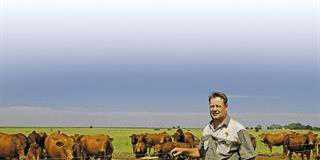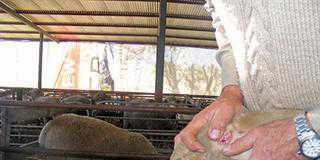Internal Parasites
* Roundworms
With the good rains that fell in large parts of the country, reports of internal roundworm parasitism were received. As wireworm resistance to anthelmintics is widespread consult your vet when selecting anthelmintic groups.
Problems with brown stomach worm were also reported from the Western Cape. Ask your vet to explain the concept of refugia when using dewormers to you. Alternatively, click here.
* Tapeworms
Infestations reported in Mpumalanga, North West, Free State, KwaZulu-Natal, Eastern and Western Cape.
* Flukes
Animals that grazed in vleis during winter may be infected with liver fluke. Discuss control and management programmes with your vet. Signs of infestation are bottle jaw and anaemia. Reports of infestation were received from Mpumalanga, NW, FS, KZN and feedlots.
Immature conical flukes cause a severe diarrhoea. Be aware of this clinical sign. Reports were received from Mpumalanga, FS, KZN and the Eastern Cape.
* Cysticercosis (measles)
Reports were received from Mpumalanga, Gauteng, FS, KZN and the Western Cape. Identify the origin of the infestation and install preventative measures. Train workers about the life cycle of Taenia saginata, the human tapeworm.
* Coccidiosis
Numerous reports from all provinces (except North West and the Northern Cape). Young animals are at risk, especially if conditions are wet and muddy. conditions are an ideal place for young animals to become infected with this parasite. Discuss preventative measures with your vet.
EXTERNAL PARASITES
* Ticks
There was a huge increase in blue tick numbers. Make sure that the control measures used are effective.
Reports of the presence of the following tick species were also received:
Heart water tick: Mpumalanga, Gauteng, Limpopo, NW, KZN, and Western and Northern Cape.
Brown ear-ticks: Mpumalanga, Gauteng, Limpopo, NW, FS, KZN and Western Cape.
Bont-legged ticks: All provinces.
Red-legged tick: Mpumalanga, Gauteng, Limpopo, NW, FS, KZN and Western Cape.
Paralysis ticks: Free State and KwaZulu-Natal.
Discuss the life cycles of these ticks and how to control them with your vet. Do not use home made pour-ons as this is a sure way of selecting for tick resistance and having residues in the meat.
* Lice
Lice (sucking and biting) numbers are decreasing. Farmers with wool sheep should check their sheep regularly for lice as they cause serious disturbance of the fleece.
* Mites
Be on the lookout for disturbances in wool and hair loss. Sheep scab is a State-controlled disease and reports of outbreaks were received from the Northern Cape. Contact your State Vet to find out if there are positive farms in your area. Biosecurity measures to prevent sheep becoming infected should be in place at all times.
* Flies, midges & mosquitoes
Numbers are on the increase after good rains in many parts of the country.
Tick-borne diseases
* African and Asiatic red water
The occurrence of these diseases is on the increase as blue tick numbers increase. Reports were received from all provinces, except the Northern Cape. Discuss vaccination programmes with your vet.
* Anaplasmosis
Numerous reports of outbreaks were received from all provinces except Gauteng and Limpopo. This disease is spread by blue ticks, biting flies and needles (vaccinations). Conditions causing stress and diseases interfering with the immune system trigger outbreaks. Discuss vaccinating cattle with your vet.
* Heartwater
Reported in all provinces except the FS and Western and Northern Cape. The occurrence of this disease is spreading as a result of game transporting the bont tick into non-infected areas. Discuss control measures with your vet.
Insect-transmitted diseases
* Lumpy skin disease
Reports were received from NW, FS, KZN and the Western and Northern Cape. This confirms that some tick species are also capable of transmitting the virus causing lumpy skin disease. Most cases occurred in animals that had never been vaccinated. If there is an outbreak on a farm the virus can also spread via the saliva, therefore isolate diseased animals as soon as possible.
* Three-day stiff sickness
An increase in the occurrence of this disease was reported in Gauteng, NW, KZN and the Eastern and Western Cape. Vaccine is not available.
* Blue tongue
Reports were received from all provinces except Limpopo and the Northern Cape. There is a crisis with the availability of vaccine. Discuss additional control measures with your vet.
* Rift Valley Fever and Wesselsbron disease
No reports were received.
Venereal diseases
* Trichomonosis
This venereal disease is causing havoc in our country. Only Gauteng, Western and Northern Cape did not experience occurrences. It was reported that many farms that were previously free of the disease, are now positive. It is of utmost importance that biosecurity measures are in place. Together with your vet plan how to prevent and control this disease.
* Vibriosis
Reports were received from the Free State and Western Cape. Good vaccines exist to control this disease.
* Pizzle disease
Reports were received from the Free State and Western Cape. Be careful not to transmit the disease when inspecting rams.
Viral diseases
* Bovine malignant catarrh (snotsiekte)
Reported in Mpumalanga, Limpopo, FS and Eastern Cape. As game farming with wildebeest, the carriers of the snotsiekte virus, is on the increase, this disease is becoming more and more important. At present there is no vaccine available. Discuss preventative measures with your vet.
Remember there’s also a sheep-associated snotsiekte virus.
* Others
Other viral diseases that were reported are: rabies, infectious bovine rhinotracheitis (IBR), bovine viral diarrhoea (BVD), enzootic bovine leucosis (EBL), jaagsiekte, orf and warts.
Bovine respiratory disease (BRD) was reported from all over the country with high mortality figures.
Bacterial diseases
The following were reported: blackquarter, pulpy kidney, lamb dysentery, swelled head, red gut, blood gut, tetanus, botulism, listeriosis, salmonellosis, bovine brucellosis, ovine brucellosis, Johnes, leptospirosis, enzootic abortion, colibacillosis, pasteurellosis and lumpy wool and senkobo.
Many new brucellosis infections were reported mainly due to positive animals being purchased. Remember – heifers that have the disease might only start to test positive after they are five months pregnant!
For most of these diseases there are vaccines.
Poisonings
The following toxicities were reported: cardiac glycoside, slangkop, tulip, ink berry (Cestrum), Cynanchum (klimop), facial eczema, dikoor, geeldikkop, Lantana, krimpsiekte, Senecio, vermeersiekte, prussic acid, chinkeretjee, mycotoxicosis, urea, copper, lead, nitrite, acidosis and snake bite.
Draw up a protocol with your vet on how to treat these poisonings should any occur on your farm.
Nutritional deficiencies
In October many reports were received of downed animals unable to get up due to a lack of energy and protein. Poor nutritional status in cows mean they have retained placentas, prolapses and metritis. These animals will also have difficulty in conceiving again.
Deficiencies reported: phosphate, calcium, iodine, copper, selenium, manganese, vitamins A and B1. Liver, blood and bone samples can be taken by your vet to get a profile of the micro and macro mineral status of your animals.
Multifactorial diseases and other conditions
The following were reported: abscesses, bladder stones, blindness, opthalmia, bloat, blood gut, blue udder, mastitis, diarrhoea, joint ill, lameness, navel ill, stomach ulcers, trauma, downer cows and pneumonia.
Metabolic conditions
The following were reported: acidosis, displaced abomasum, ketosis and milk fever.
Reproductive disorders
The following were reported: abortions, dystocias, endometritis, metritis, poor conception, retained afterbirths and prolapses.
Feedlot report
Sheep feedlots
- Pulpy kidney, blood gut, adaptation problems and acidosis are often seen. Lambs in poor condition take about three weeks before they start eating properly and a lot of lambs die in spite of receiving good nutrition. It was noted that that the whole gastrointestinal tract atrophied in such a way that healing took place too slowly or not at all. Some of these lambs also die when bad weather occurs as they have no fat reserves and their energy intake is too low.
- Cases of Sarcocystis infections were seen at an abattoir. This is a condition where parasite lesions occur in muscles which look similar to measles. The infection usually comes from dogs or jackals which spread the infection in their faeces. This is why dogs are not allowed in the feedlot.
- Sheep were seen where the whole fleece was shed. The condition was caused by the Pseudomonas bacteria which occur naturally on the skin. Fleece rot occurs when the skin stays wet for an extended period allowing the bacteria to multiply and secretes a toxin which causes a fever. This, in turn, leads to a break in the wool.
Cattle feedlots
- In many cases adhesions of the lungs, active pleuritis and pneumonia were seen. Lungs and even carcasses were condemned. This is the typical result of the dusty, windy conditions which occurred after winter.
- Red gut, bloat and acidosis were also more frequent.
- Parafilaria lesions (false bruising) were seen at abattoirs, causing economic loss.
- Measles are regularly seen at abattoirs in spite of precautionary measures taken by feedlots. Samples taken in formalin confirmed that, in most cases, the cattle were already infected when they arrived at the feedlot.
- Lumpy skin cases were reported. False lumpy skin cases caused by the Allerton virus were also seen. This is a less pathogenic virus and causes superficial lesions mostly on the neck and front quarters. It occurs mainly in early summer and is often misjudged as failure of the lumpy skin vaccine.
- Dermatosparaxis was seen periodically. This is a congenital condition where the animal does not have enough connective tissue in the skin, meaning the skin tears easily when the animal bumps against an object. The open wounds take a long time to heal and in the summer blowflies and maggots cause serious problems.













